(译林版)小升初英语语法整理
译林版小升初英语知识点整理
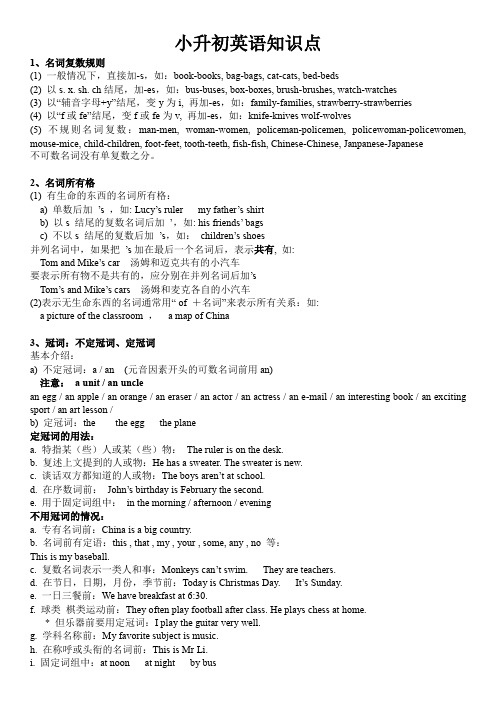
小升初英语知识点1、名词复数规则(1) 一般情况下,直接加-s,如:book-books, bag-bags, cat-cats, bed-beds(2) 以s. x. sh. ch结尾,加-es,如:bus-buses, box-boxes, brush-brushes, watch-watches(3) 以“辅音字母+y”结尾,变y为i, 再加-es,如:family-families, strawberry-strawberries(4) 以“f或fe”结尾,变f或fe为v, 再加-es,如:knife-knives wolf-wolves(5) 不规则名词复数:man-men, woman-women, policeman-policemen, policewoman-policewomen, mouse-mice, child-children, foot-feet, tooth-teeth, fish-fish, Chinese-Chinese, Janpanese-Japanese不可数名词没有单复数之分。
2、名词所有格(1) 有生命的东西的名词所有格:a) 单数后加’s ,如: Lucy’s ruler my father’s shirtb) 以s 结尾的复数名词后加’,如: his friends’ bagsc) 不以s 结尾的复数后加’s,如:children’s shoes并列名词中,如果把’s加在最后一个名词后,表示共有, 如:Tom and Mike’s car 汤姆和迈克共有的小汽车要表示所有物不是共有的,应分别在并列名词后加’sTom’s and Mike’s cars 汤姆和麦克各自的小汽车(2)表示无生命东西的名词通常用“ of +名词”来表示所有关系:如:a picture of the classroom , a map of China3、冠词:不定冠词、定冠词基本介绍:a) 不定冠词:a / an (元音因素开头的可数名词前用an)注意: a unit / an unclean egg / an apple / an orange / an eraser / an actor / an actress / an e-mail / an interesting book / an exciting sport / an art lesson /b) 定冠词:the the egg the plane定冠词的用法:a. 特指某(些)人或某(些)物:The ruler is on the desk.b. 复述上文提到的人或物:He has a sweater. The sweater is new.c. 谈话双方都知道的人或物:The boys aren’t at school.d. 在序数词前:John’s birthday is February the second.e. 用于固定词组中:in the morning / afternoon / evening不用冠词的情况:a. 专有名词前:China is a big country.b. 名词前有定语:this , that , my , your , some, any , no 等:This is my baseball.c. 复数名词表示一类人和事:Monkeys can’t swim. They are teachers.d. 在节日,日期,月份,季节前:Today is Christmas Day. It’s Sunday.e. 一日三餐前:We have breakfast at 6:30.f. 球类棋类运动前:They often play football after class. He plays chess at home.* 但乐器前要用定冠词:I play the guitar very well.g. 学科名称前:My favorite subject is music.h. 在称呼或头衔的名词前:This is Mr Li.i. 固定词组中:at noon at night by bus4、代词:人称代词、物主代词人称代词物主代词主格宾格第一人称单数I(我)me my(我的)复数we(我们)us our(我们的)第二人称单数you(你)you your(你的)复数you(你们)you your(你们的)第三人称单数he(他)him his(他的)she(她)her her(她的)it(它)it its(它的)复数they(他们/她们/它们)themtheir(他们的/她们的/它们的)5、数词:基数词、序数词基数词(1)1-20one,two,three,four,five,six,seven,eight,nine,ten,eleven,twelve,thirteen,fourteen,fifteen,sixteen,seventeen,eighteen,nineteen,twenty(2)21-99:先说“几十”,再说“几”,中间加连字符。
2023年小学英语六年级小升初语法总复习(四)一般将来时 (译林版含答案)
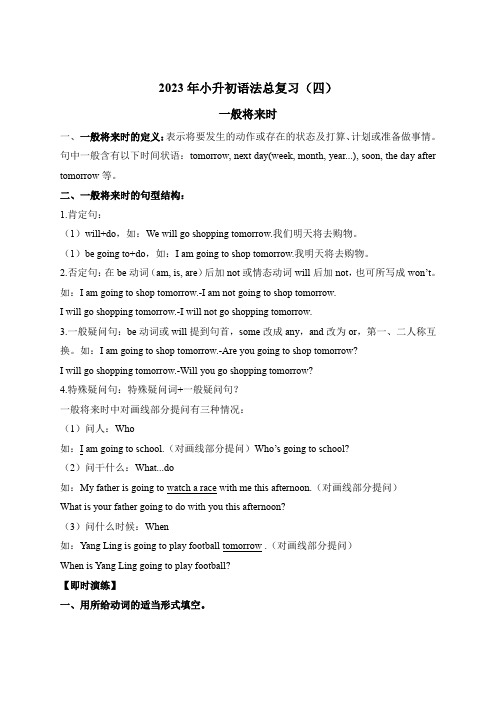
2023年小升初语法总复习(四)一般将来时一、一般将来时的定义:表示将要发生的动作或存在的状态及打算、计划或准备做事情。
句中一般含有以下时间状语:tomorrow, next day(week, month, year...), soon, the day after tomorrow等。
二、一般将来时的句型结构:1.肯定句:(1)will+do,如:We will go shopping tomorrow.我们明天将去购物。
(1)be going to+do,如:I am going to shop tomorrow.我明天将去购物。
2.否定句:在be动词(am, is, are)后加not或情态动词will后加not,也可所写成won’t。
如:I am going to shop tomorrow.-I am not going to shop tomorrow.I will go shopping tomorrow.-I will not go shopping tomorrow.3.一般疑问句:be动词或will提到句首,some改成any,and改为or,第一、二人称互换。
如:I am going to shop tomorrow.-Are you going to shop tomorrow?I will go shopping tomorrow.-Will you go shopping tomorrow?4.特殊疑问句:特殊疑问词+一般疑问句?一般将来时中对画线部分提问有三种情况:(1)问人:Who如:I am going to school.(对画线部分提问)Who’s going to school?(2)问干什么:What...do如:My father is going to watch a race with me this afternoon.(对画线部分提问)What is your father going to do with you this afternoon?(3)问什么时候:When如:Yang Ling is going to play football tomorrow .(对画线部分提问)When is Yang Ling going to play football?【即时演练】一、用所给动词的适当形式填空。
完整版)译林版小升初英语公式及固定搭配

完整版)译林版小升初英语公式及固定搭配1.加动词原形可以使用can/can’t、will/won’t、shall we、should/shouldn’t、XXX、祈使句、may、help、must/mustn’t和have to加上动词原形。
例如:Can you speak English。
I won’t go to the party。
Shall we play soccer?2.+to+动词原形可以使用want、would you like、it’s time、how、be happy、can’t wait to、need、let、would like和use… to加上动词原形。
例如:I want to eat pizza。
Would you like to come with us。
It’s time to go home.3.+动词ing可以使用be。
no、how about/what about、go、be good at、like、do well in、love、介词+动词ing、start+动词ing和begin+动词ing加上动词ing。
例如:XXX?4.后面跟形容词的动词有be、keep、look、feel、get、stay、e、make、smell、sound和turn。
例如:She looks happy。
He made me angry.5.量词常用的量词有a lot of、some、a few、a little、many、much、too many和too much。
例如:I have a lot of friends。
Can I have some water?6.XXX的用法the常用于特定的事物或人,表示唯一或特定的对象。
例如:The sun is shining。
I saw the movie last night.3.Walk继续走:walk on路过:walk by穿过:XXX4.Up叫醒:wake…up吵醒狮子:wake XXX up捡起:pick …up把它/它们捡起来:pick it/them up爬上:climb up爬上小山:climb up the hill起床:get up5.Away飞走:fly away赶走:XXX走了,离开:go XXX从…搬走:XXX…away from …6.XXX把……倒入:pour…into走进,进入:go into抓紧:hold onto带入……:XXX…into…变成:turn into7.其它词:about。
译林版小升初英语知识点大汇总

译林版小升初英语知识点大汇总(总7页)-本页仅作为预览文档封面,使用时请删除本页-2019小升初英语知识点大汇总小升初英语语法1、名词复数规则、1.一般情况下,直接加-s,如:book-books, bag-bags, cat-cats, bed-beds2.以s. x. sh. ch结尾,加-es,如:bus-buses, box-boxes, brush-brushes, watch-watches3.以“辅音字母+y”结尾,变y为i, 再加-es,如:family-families, strawberry-strawberries4.以“f或fe”结尾,变f或fe为v, 再加-es,如:knife-knives5.不规则名词复数: man-men, woman-women, policeman-policemen, policewoman-policewomen, mouse-mice child-children foot-feet,.tooth-teeth fish-fish, people-people, Chinese-Chinese, Japanese-Japanese5.2、一般现在时1.一般现在时表示经常或习惯性的动作,也可表示现在的状态或主语具备的性格和能力。
2.一般现在时中,没有be动词和情态动词,主语为第三人称单数的肯定句,动词要按规则加上s,主语是非第三人称单数的肯定句,动词用原形。
3.在一般现在时中,句中有be动词或情态动词时,否定句在be动词和情态动词后加not,一般疑问句将be动词或情态动词放在句首。
4.在一般现在时中,句中没有be动词或情态动词时,主语为第三人称单数的否定句在动词前加does+not (doesn’t),一般疑问句在句首加does,句子中原有动词用原形;主语为非第三人称单数,否定句用do+not (don’t),一般疑问句在句首加do,句子中动词用原形。
译林小升初英语语法提升--必背速记口诀

译林小升初英语语法提升必背速记口诀班级__________ 姓名 ___________ 学号___________句型转换口诀一般疑问句和否定句变化口诀:一般问句并不难,谓语调到主语前。
大写小写有变化,句末要把问号加。
第一人称常变二。
否定句就更简单,中间加上一not,谓语动词提到前。
特殊疑问句速记:特殊疑问句,变起来有程序,第一,确定疑问词,第二,代替划线语,第三,将疑问词放句首,疑问词后加一般疑问句,语序倒置要牢记。
时态口诀一般现在时口诀一般现在时,表示常常做的事,非单三人称作主语,动词原形就可以,疑问否定也不难,do和don't来成全,单三人称作主语,动后加属规律,结尾若是sh,ch,s,和x,后加es别忘记,疑问否定用does和doesn't,句中动词现原形,时间状语用often,sometimes也可以。
现在进行时口诀说的是目前正做的事,Be+动词ing,变疑问Be提前,变否定也容易,Be后not加上去,时间状语用nowLook, listen是语境。
一般将来时口诀一般将来时,是说将要发生的事,Will后加原形动词,一人称可用shall替,否定疑问很容易,只用will,shall就可以,next, later, tomorrow时间状语要牢记时间名词前所用介词年月周前要用in 日子前面却不行遇到几号要用on,上午下午又是in要说某日上下午,用on换in才能行午夜黄昏须用at,黎明用它也不错at也用在明分前,说差可要用上to多说多练牢牢记,莫让岁月空蹉跎。
一般过去时口诀:规则动词加ed,不规则的必须记否定形式疑问句,没有be就加did如把did加在前,动词也要还原形动词口诀be动词速记:be动词有三个am, is还有areI跟am, you跟areis连着他,她,它,单数后面跟is,复数后面都跟are.have/has速记:have/has表拥有,你有我有大家有;两种形式有不同,男他女她动物它,张三李四单个他,has与之紧相伴;其他形式都跟have。
2023年小学英语六年级小升初语法总复习(二)现在进行时 (译林版含答案)

2023年小升初语法总复习(二)现在进行时1.现在进行时的定义:表示现在正在进行或发生的动作,也可表示当前一段时间内的活动或现阶段正在进行的动作。
句中一般含有now, look, listen等词。
2.现在进行时的句型结构:(1)肯定句:主语+be动词+现在分词+其他.如:Tom is reading newspapers in the living room.汤姆正在客厅里看报纸。
(2)否定句:主语+be动词+not+现在分词+其他.如:Tom is not reading newspapers in the living room.汤姆没有在客厅里看报纸。
(3)一般疑问句:Be动词+主语+其他?(be动词提到句首)如:Is Tom reading newspapers in the living room?汤姆正在客厅里看报纸吗?(4)特殊疑问句:特殊疑问词+一般疑问句?【注意】当画线部分包含谓语动词时,用特殊疑问词代替画线部分放到句首,原画线处应加上doing。
如:Tom is reading newspapers in the living room.(对画线部分提问)What is Tom doing in the living room?3.动词现在分词的变化规则:(1)一般情况下,在词尾直接加-ing。
如:cook-cooking, look-looking, listen-listening。
(2)以不发音的e结尾的单词,去e加-ing。
如:make-making, taste-tasting。
(3)以重读闭音节结尾,且词尾只有一个辅音字母,则双写这个辅音字母,再加-ing。
如:run-running, stop-stopping, put-putting。
【即时演练】一、单项选择。
( )1.My brother his car in the garden now.A.washesB.is washingC.washed( )2.—Can Peter play games with us, Mrs Frank?—No. He a shower at this moment.A.is takingB.takesC.took( )3.Tom often swimming. But now he football.A.go; is playingB.goes; playsC.goes; is playing ( )4.—Alice, don’t play the guitar! I on the phone.—Oh, sorry, Mum.A.talkingB.talkC.am taking ( )5.Shh! My sister now.A.sleepsB.is sleepingC.sleep( )6.Listen! Mary an English song in the classroom.A.is singingB.singC.sings二、用所给单词的适当形式填空。
译林版小升初英语公式及固定搭配

译林版小升初英语公式及固定搭配小升初英语公式及固定搭配(译林版)一、公式类:1.动词+名词(动名词)例句:She enjoys swimming in the pool.(她喜欢在游泳池里游泳。
)2. 动词+ to do (不定式)例句:I want to go shopping.(我想去购物。
)3. 主语+ be+ 形容词例句:The book is interesting.(这本书很有趣。
)4. 主语+ be + 名词例句:He is a teacher.(他是一名教师。
)5. 主语+ be+ from+ 地点例句:My friend is from China.(我的朋友来自中国。
)6. be+ 感觉动词例句:I am hungry.(我饿了。
)7. be+ 形容词+ 名词例句:She is a beautiful girl.(她是一个漂亮的女孩。
)8. be+ 动词+ 名词例句:This is a place to play.(这是一个玩耍的地方。
)9. 主语+ have+ 名词例句:They have a pet dog.(他们养了一只宠物狗。
)10. 主语+ can/ can’t+ 动词原形例句:I can swim.(我会游泳。
)/ I can’t swim.(我不会游泳。
)二、固定搭配类:1. be good at(擅长)例句:She is good at playing the piano.(她擅长弹钢琴。
)2. be interested in(对…感兴趣)例句:He is interested in playing basketball.(他对打篮球感兴趣。
)3. be famous for(以…闻名)例句:China is famous for the Great Wall.(中国以长城闻名。
)4. be different from(与…不同)例句:My hobby is different from yours.(我的爱好与你的不同。
【译林版专用】小升初英语语法复习讲义——形容词、副词(含答案)
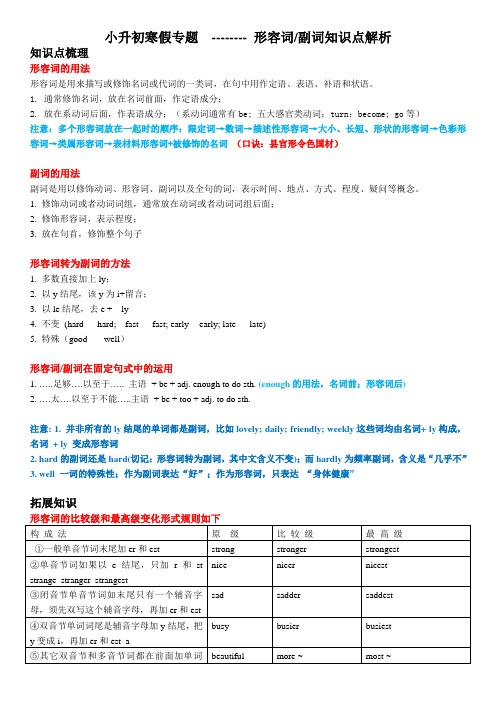
小升初寒假专题-------- 形容词/副词知识点解析知识点梳理形容词的用法形容词是用来描写或修饰名词或代词的一类词,在句中用作定语、表语、补语和状语。
1. 通常修饰名词,放在名词前面,作定语成分;2. 放在系动词后面,作表语成分;(系动词通常有be; 五大感官类动词;turn;become; go等)注意:多个形容词放在一起时的顺序:限定词→数词→描述性形容词→大小、长短、形状的形容词→色彩形容词→类属形容词→表材料形容词+被修饰的名词(口诀:县官形令色国材)副词的用法副词是用以修饰动词、形容词、副词以及全句的词,表示时间、地点、方式、程度、疑问等概念。
1. 修饰动词或者动词词组,通常放在动词或者动词词组后面;2. 修饰形容词,表示程度;3. 放在句首,修饰整个句子形容词转为副词的方法1. 多数直接加上ly;2. 以y结尾,该y为i+留言;3. 以le结尾,去e + ly4. 不变(hard --- hard; fast --- fast; early -- early; late --- late)5. 特殊(good ---- well)形容词/副词在固定句式中的运用1. …..足够….以至于….. 主语+ be + adj. enough to do sth. (enough的用法,名词前;形容词后)2. ….太….以至于不能…..主语+ be + too + adj. to do sth.注意: 1. 并非所有的ly结尾的单词都是副词,比如lovely; daily; friendly; weekly这些词均由名词+ ly构成,名词+ ly 变成形容词2. hard的副词还是hard(切记:形容词转为副词,其中文含义不变);而hardly为频率副词,含义是“几乎不”3. well 一词的特殊性;作为副词表达“好”;作为形容词,只表达“身体健康”拓展知识比较级用法(两者之间)1. 句子中有than(比)2. A or B, which is 比较级3. 有much; far; even修饰最高级用法(三者之间或三者以上)1. 句中有one of2. A, B, or C基础题练习一、写出系动词(至少6个)________________________ ________________________ ________________________ ________________________ ________________________ ________________________二、将下列形容词变为副词1. happy ________________________2. slow______________________3. careful________________________4. quick____________________5. comfortable____________________6. angry___________________7. real ________________________ 8. terrible ________________________ 9. late ________________________ 10. early ________________________ 11. good ________________________ 12. hard_________________三、选择题( )1. He looks .A. happyB. happilyC. sadly( )2. Do you feel now ? Thanks , I’m Ok.A. goodB. wellC. badly( )3. My sister is to look after herself.A. old enoughB. enough oldC. older enough( )4. There isn’t to every student.A. book enoughB. books enoughC. enough books( )5. He is ill today. So he looks .A. tiredB. happilyC. sadly( )6. My brother doesn’t feel today.A. goodB. wellC. happily( )7. The food smells . I don’t like itA. goodB. badlyC. bad( )8. He writes very .A. carefulB. carefullyC. bad( )9. I study very .A. hardB. hardlyC. careful( )10. Our country is becoming _______.A. strongB. stronglyC. richly( )11. Is there in the newspaper?A. something newB. new anythingC. anything new( )12. There is with my bike. It works well.A. nothing wrongB. wrong somethingC. something wrong( )13. He speaks for me to understand.A. too slowlyB. slowly enoughC. enough slowly( )14. He runs to catch up with me .A. too fastB. quick enoughC. quickly enough四、用恰当的词填空1. My father feels ___________ (good) today.2. _________(happy), I passed the exam.3. My father looks ____________(angry).4. My father looks ______________(angry) at me.5. She did her homework very ______________(careful).6. Lily is ____________(care). And she does everything ______________(careful).7. Don’t drive _____________(quick) on rainy days.8. They gave us a _______________(warm) welcome.9. They welcome us _____________(warm).10. The fish taste very ____________(bad).11. The flowers smell _______________(sweet).12. Your ideas sound ________________(great).13. ___________(lucky), he wasn’t badly hurt in the car crash.14. He is _____________(bad) ill.15. There are many _______________(beautiful) flowers.提高题练习一、写出以下各形容词的比较级和最高级1. nice _________ _________2. fat _____ ________3. slow _______ ___________4. dry __________ _________5. happy ________ _________6. wet ________ ____________7. much _______ _________8. ill ________ _________9. little ________ __________ 10. bad _________ _________ 11. thin __________ _________ 12. far _________ ___________ 13. early _______ _________ 14. careful_________ _________ 15. exciting _____ ___________16. busy __________ ________二、根据单词的合适形式填空1. Fred is the _________________ (short ) in his class .2. My book is ____________ ( new ) than my sister’s .3. That piece of chicken is the _________________ ( heavy )in the fridge .4. Her rule is _________________(long), and it’s the __________________(long)of ours all .5. Is a fish ____________________(thin) than a bird ?6. A rose tree isn’t __________________( short ) than a pear tree .7. The leopard can run __________________( fast), but the cheetah can run ________________( fast) than it . It can run ___________________( fast ) in the world .8. Is she the ___________________(old ) woman in the world ?9. Which is __________________( big ), a dinosaur or a blue whale ?The blue whale is ____________________( big ) than a dinosaur , it is the __________________(big) animal in the world . And elephant is the ___________________(big) animal on land .10. My father leaves home __________________(early ) than me .11. This zoo is much __________________(good ) than the old one .12. My brother is much __________________(tall ) than my cousin .13. The shoe shop is ____________________(near) the park .14. This bag is very ___________________( heavy), but that one is __________________(heavy) than this one . It’s the ___________________( heavy) of all .15. Jiamin is __________________( tall ). But Yongxian is __________________( tall ) than him .三、单选题1. Lucy is very short, but she is __________ than her sister.A. shorterB. longerC. tallerD. older2. Sam is __________ at Chinese than Jim.A. goodB. wellC. betterD. gooder3. This one is too large. Can you show me a __________one?A. largerB. largeC. smallD. smaller4. —Do you think March is __________ than January?—Yes, it’s __________ warmer.A. better, a littleB. well, muchC. worse, veryD. nicer, quite5. His Frenc h isn’t so good as __________.A. herB. sheC. hisD. hers6. Her bag is newer than __________.A. mineB. myC. meD. I7. Lin Tao is younger than __________ boy in his class.A. any othersB. any otherC. the otherD. the others8. Which one is __________, this one or that one?A. goodB. badC. bestD. worse9. The weather in North China is colder than __________ in South China.A. \B. thisC. the oneD. that10. I think your room is __________ bigger.A. a lotB. a lot ofC. lots ofD. more11. She is only 2 years old. She is ________go to school.A. too young toB. young enough toC. enough young toD. too young not to12. The room is _____ to put down these things.A. large enoughB. enough largeC. enough bigD. too large13. Do you have ______ to buy the books? --- Yes. But I am too little _____ carry them.A. enough money; toB. money enough; not toC. enough money; / D/ money enough; to14. The room is big enough ____ me to live ____.A. for; inB. to; /C. for; /D. for; on15. She is one of ____________ in our class.A. the tallest studentB. tallest studentsC. the tallest studentsD. tall students基础题练习一、写出系动词(至少6个)feel; look; taste; smell; sound; be; seem二、将下列形容词变为副词略三、选择题ABACA BCBAA CABA四、用恰当的词填空1. well2. Happily3. angry4. angrily5.carefully6. careful; carefully7. quickly8. warm9. warmly 10. bad11. sweet 12. great 13. Luckily 14. badly 15. beautiful提高题练习一、写出以下各形容词的比较级和最高级1. nicer nicest2. fatter fattest3. slower slowest4. drier driest5. happier happiest6. wetter wettest7. more most 8. worse worst 9. little less least10. worse worst 11. Thinner thinnest 12. farther farthest13. earlier earliest 14. More careful most careful15. more exciting most exciting 16. busier busiest二、根据单词的合适形式填空1. shortest2. newer3. heaviest4. longer longest5. thinner6. shorter7. fast faster fastest8. oldest9. bigger; bigger; biggest; biggest 10. earlier 11. better 12. taller 13. nearer 14. heavy; heavier; heaviest 15. tall taller三、单选题CCDAD ABBDA AAAAC。
译林版小升初英语公式及固定搭配
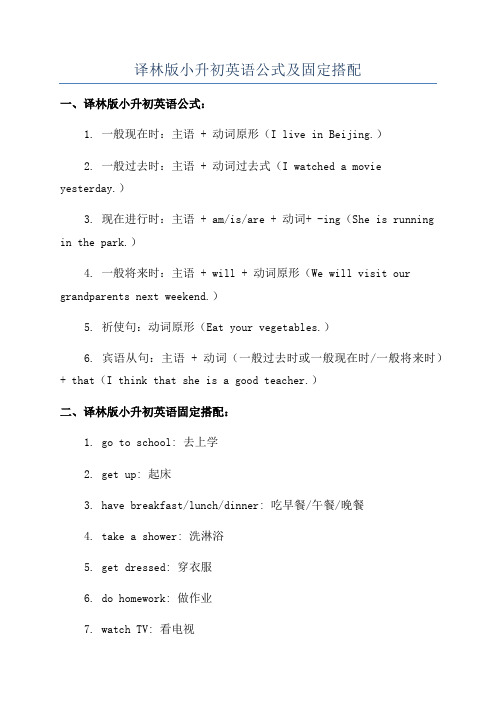
译林版小升初英语公式及固定搭配一、译林版小升初英语公式:1. 一般现在时:主语 + 动词原形(I live in Beijing.)2. 一般过去时:主语 + 动词过去式(I watched a movie yesterday.)3. 现在进行时:主语 + am/is/are + 动词+ -ing(She is running in the park.)4. 一般将来时:主语 + will + 动词原形(We will visit our grandparents next weekend.)5. 祈使句:动词原形(Eat your vegetables.)6. 宾语从句:主语 + 动词(一般过去时或一般现在时/一般将来时)+ that(I think that she is a good teacher.)二、译林版小升初英语固定搭配:1. go to school: 去上学2. get up: 起床3. have breakfast/lunch/dinner: 吃早餐/午餐/晚餐4. take a shower: 洗淋浴5. get dressed: 穿衣服6. do homework: 做作业7. watch TV: 看电视8. play sports/games: 进行运动/玩游戏9. go to bed: 上床睡觉10. have a picnic: 去野餐11. do housework: 做家务12. do the shopping: 购物13. take care of: 照看/照顾14. look after: 照看/照顾15. get on/off: 上/下(车,飞机等)16. wait for:等待17. look for: 寻找18. take a walk: 散步19. write a letter: 写信21. visit a museum: 参观博物馆22. go on a trip: 去旅行23. have a party: 举办派对24. go to the cinema: 去电影院看电影25. play the piano/guitar: 弹钢琴/吉他26. buy some presents: 买一些礼物27. make a cake: 做蛋糕28. go to the park: 去公园29. take a bus/taxi: 坐公交车/出租车30. fly a kite: 放风筝。
2023江苏译林版 六年级 小升初 英语 升学复习提纲总结

2018年学校期中工作的小结-推荐word版本文部分内容来自网络整理,本司不为其真实性负责,如有异议或侵权请及时联系,本司将立即删除!== 本文为word格式,下载后可方便编辑和修改! ==学校期中工作的小结在校长室的正确领导下,在全校师生的大力配合下,政教处根据学期初的工作计划,主要完成了如下工作:进一步加强了常规工作的管理力度,抓卫生、促纪律、保安全、养习惯,总结“海门未成年人寒假文明素质提升行动”活动、迎接开学工作的检查、加强生活指导处和宿舍检查的管理、精心组织一月一事的主题教育月活动、 XX——XX年第一学期和第二学期学生综合素质评定系统操作、学生干部培训、适应新形势加强校园安全工作管理力度等工作。
一、加强常规工作的管理力度在全体班主任的辛苦付出、密切配合下,全校的卫生状况、各年级学生的自修、就寝纪律良好,学生的行为习惯文明,没有发生较大的安全事故。
全体初三班主任干劲足、热情高、到位早,效果好。
初三(4)班班主任倪耀红老师脚部受伤后依然每天坚守岗位,感动了领导、同事、所有的学生和家长。
初二年级班主任责任心强,办法多,他们能充分发挥班干部的作用,做到老师不在与老师在一个样,尤其是陆萍和梅红两位班主任能坚持每天的全程管理,值得敬佩。
初一年级学生年龄小,活泼好动,班级人数多,管理难度最大,但全体初一班主任能不辞辛苦,克服困难努力把班级管理好,本学期在自习课纪律、课间休息和文明习惯等方面已比上学期大有进步,特别是初一1、2、4、6、10等班级班风正、学风浓。
希望在后阶段部分班级的班主任能虚心向有经验的爱思考的班主任学习,在管理细节上做文章,在管理效率上动脑筋。
本学期在学生会的组织下,学生会劳动部成员和各值周班高度负责,认真检查,经过和宿舍管理分的综合统计,初一年级1——10周的值周最高总分初一10班1088.03分,第二至第五名的班级为初一9、初一2、初一1、和初一7班,最低分为1069.62分;初二年级1——10周的值周最高总分初二5班1094.66分,高居全校第一,第二至第五名的班级为初二9、初二2、初二7、和初二8班,最低分为1084.96分;初三年级1——10周的值周最高总分初三5班1089.39分,第二第三名为三4和三2班,最低分为1080.52分。
译林版小升初英语公式与固定搭配

译林版小升初英语公式与固定搭配一、公式1. What + be + 主语+like?这是一个常见的问句公式,用来询问人或物的特征、品质或个性。
例如:- What is your sister like?(你的姐姐是什么样的?)- What is the weather like today?(今天的天气如何?)- What is your favorite color?(你最喜欢的颜色是什么?)2. How + be + 主语?这是一个常见的问句公式,用来询问人或物的状况、感受或状态。
例如:- How is your father today?(你爸爸今天怎么样?)- How is your new school?(你的新学校怎么样?)- How are you feeling?(你感觉怎么样?)3. There be + 主语+地点这是一个常见的存在句公式,用来描述一些地方有什么或发生了什么事情。
例如:- There is a book on the desk.(桌子上有一本书。
)- There are many people in the park.(公园里有很多人。
)- There was a car accident on the highway.(公路上发生了一起车祸。
)4. 主语+have/has + to + 动词原形这是一个常见的表达“必须、需要做事”的句型。
例如:- I have to go to school every day.(我每天都必须去上学。
)- She has to do her homework before she can play.(她必须先写完作业才能玩。
)- They have to clean their room before they can watch TV.(他们要先整理房间才能看电视。
)5. 主语+be + doing这是一个常见的表示正在进行的动作的句式。
【译林版专用】小升初英语语法复习讲义—— 冠词 (含答案)

小升初寒假专题-------- 冠词知识点梳理考点一不定冠词a, an的用法1. 不定冠词通常用于单数可数名词前,a用于以辅音音素开头的单词前,而an则用于以元音音素开头的单词前。
2. 表示类别,泛指一类人或物;3. 表示“每一”,相当于every;4. 表示再一次;Eg: a second time 再次5. 用于固定短语中。
考点二定冠词the的用法定冠词the与指示代词this, that, these, those意义相当,用于不可数名词、可数名词单复数前,表示某个或某些定的人或事物。
1. 表示特指时用定冠词the;2. 表示说话双方都知道的人或事;3. 指上文已提到的人或事物;4. 用于世界上独一无二的事物前;5. 用于序数词和形容词最高级前;6. 用在中国乐器名词前;7. 用在姓氏复数形式前,表示“全家人”或“夫妇俩”;Eg: the Blacks 布莱克一家人8. 用于某些固定搭配中。
Eg: same前面必须加the9. 表示一类人Eg: the poor穷人the rich 富人10. 用在含有2个以上名词构成的江河;湖海等;Eg: the Yellow River; the Great Wall考点三零冠词的情况1. 复数名词或不可数名词表示一般意义而不指具体的人或事物时,不用冠词;2. 名词前有this, that, my, your, their, whose, these, some, any, no, each, every等代词时,不用冠词;3. 学科﹑球类﹑三餐前不加任何的冠词;4. 颜色和具体的语言前不加任何冠词;5. 在国名和地名前不用任何的冠词;6. 职务﹑称呼语和头衔前不加任何冠词;7. 用于一些固定短语中。
Eg:by +名词表时候交通方式,不加冠词基础题专练一、运用恰当的a/an填空1. _______ useful book2. ______ university3. _____ unhappy boy4. _____ hour ago5. _____ unusual day6. ______ usual day7. ______ smart dog8. ____ umbrella9. ______”s” and ______”u”10. _____ American student11. _____ English book12. give me ______ cup of coffee13. ______ good boy14. _____ orange15. ______ egg 16. _____ student17. miss ______”m”18. ______ one-year-old baby19. half ______ hour20. _____ honest boy二、用适当的冠词填空1. This is ___ old map. It is ____ useful map.2. _____Blacks are sitting in the living room.3. Which is ________ biggest, ______ sun, _______ moon; or ______ earth?4. This is _______ useful book. I read it for _______ hour.5. There is _____woman over there. ____ woman is Lily’s mother .6. What _____ important news!7. He often goes to _____ school by ____ bike.8. I often watch _____ TV in _____ evening.9. There is _____”s” and _____”m” in _____word”miss.”10. Do n’t play _____ basketball at home. You can play _____ guitar.11. Are ____ Greens going to Shanghai for holiday?12. It will take you half ____ hour together there on ____ bus.13. Let’s go out for _____ walk.st night I saw________ UFO flying in the sky and took pictures of it.15. Tim had tried twice, and his father asks him to have________ third try.16. Many students in our school can play________ guitar.17. Liu Changchun is________ first Chinese to join the Olympics.18. I think it’s________ useful advice, so I will always remember it.19. —Will you get there by________ train? —No, I’ll take _______ taxi.20. We work five days ________ week.21. There’s _______ “u” and _______ “s” in ______ word “use”.22. That’s ______ useful book. I have read it already.23. ______ Whites have moved to a new house.提高题精练1. --- What _______ great time they had at the party yesterday!A. aB. theC. anD. /2. What ____ great fun they had at the party yesterday!A. aB. theC. anD. /3. We’ll go traveling by ____ camel across the desert before we go to ____ university.A. a; /B. /; anC. /; /D. /; a4. ____ Greens are preparing for the coming Thanksgiving Day.A. aB. theC. anD. /5. This summer, I’m going to visit _____ Great Wall.A. aB. theC. anD. /6. ____ apple a day keeps the doctor away.A. AnB. TheC. AD. /7. At that time, Tom was _____ one-year-old baby.A. aB. theC. anD. /8. ____ useful book it is!A. What aB. How aC. What anD. What9. One afternoon, he found ____ handbag. There was ____”s” on the corner of _____ handbag.A. a; a; theB. a; an; theC. an; an; aD. the; an; the10. ____ Great Wall is ____ longest wall in the world.A. The; aB. The; aC. /; /D. The; the11. The museum is quite far. It will take you half ____hour to get there by ____ bus.A. an; aB. a; aC. an; /D. /; a12. ___ elephant is much heavier than _____ horse.A. A; aB. The; theC. An; aD. /; /13. Washington is _____ capital of ____ USA.A. the; theB. a; theC. a; /D. the; /14. After watching TV, she played ____ violin for _____ hour.A. the; theB. a; theC. a; aD. the; an15. Susan, _____ university student from Europe, teaches me _____ art in her free time.A. an; /B. a; theC. a; /D. a; a16. Now he is _____ artist. I have known him(认识)since(自从) he was _____ one –year-old boy.A. a; anB. an; aC. an; anD. a; a17. We found that we should do more for _______ poor in the poor area.A. /B. aC. theD. those18. They went to see _____Yellow River two days ago. And they arrived(到达) ______ home yesterday.A. the; /B./; theC. /; /D. the; the19. The boy is on ____ left of that boy. And two boys look ____ same.A. the; theB. /; /C. a; aD. the; /20. We should give the seats to _______ elderly on the bus.A. theB. /C. aD. an21. _____ Browns live in ___United States.A. The; theB. /; /C. A; aD. the; /22. _____ Spring Festival is ____ most important holiday in _____ China.A. The; the; theB. /; /; theC. A; a; /D. The; the; /23. Do you like studying _____Maths or ______Chinese?A. the; theB. /; /C. a; aD. the; /24. I think it is _____ hard work for me to finish the job in twenty minutes.A. theB. /C. aD. an25. Does Wuxi have_____ airport? --- Yes, we can go to ____ UK on ____ plane.A. a; the; /B. an; the; theC. the; the; aD. the; the; /基础题专练答案一、运用恰当的a/an填空1~ 10 : A; a; an; an; an; a; a; an; an, a; an;11~20: an; a; a; an; an; a; an; a; an ;an二、用适当的冠词填空1. an; a2. The3. the; the; the ; the4. a; an5. a; The6. /7. /; /8. /; the9. an; an; the 10. /; the 11. the 12. an; the 13. a 14.a 15. a 16. the 17. the 18. / 19. /; a 20.a21. a; an; the 22. a 23. The提高题精练ADDBB AAABD CCADC BCAAA ADBBB。
【译林版专用】小升初英语语法复习讲义—— 感叹句、祈使句(含答案)

小升初寒假专题-------- 感叹句/祈使句知识点梳理感叹句what / how的使用1. what的使用,what用于修饰名词或者名词词组;做题时找准感叹句中的主语,再看主语前面的单词的词性;Eg: What good news we heard! We heard是这句话的主语和谓语动词,而we前面的单词news是名词,所以用what.What的类型:what + a / an +adj. +名词单数+ 主语+ 谓语+ 其他!what + adj. +名词复数+ 主语+ 谓语+ 其他!what +adj. +不可数名词+ 主语+ 谓语+ 其他!2.how的使用,how用于修饰副词或者修容词,做题时,方法同上。
Eg: How good the news was! 这句中的主语是the news, 而主语前面是good, good是形容词, 所以用how.How的类型:How + adj./ adv + 主语+ 谓语+ 其他!注意: 1. 感叹句what / how的本质作用,只是起到增强语气的作用,在句子中不会充当任何的成分。
做完题目后,可以去掉what/how。
来还原句子,检测答案对不对。
2. 感叹句what一词,一定要考虑名词的单复数问题以及名词的不可数性问题。
3. 若在词汇的正确形式中遇到感叹句,切记去感叹词what; how;然后将句子还原来做题。
祈使句的使用祈使句分类:肯定祈使句----- A. 行为动词原形+ 其他B. Be 动词+ 其他否定祈使句----- A. Don’t 行为动词原形+ 其他B. Don’t be 动词+ 其他C. No + ving特殊祈使句:Let sb. do sth. / Let sb. not do sth.祈使句的回答:用will或者won’t来回答。
如果句子是肯定,就用will; 如果是否定,就用wo n’t.Eg:---- Don’t drive so quickly, Bobby. ---- Ok, I won’t.祈使句的反义疑问句:Let’s的反义疑问句,shall we?其余的祈使句的反义疑问句,will you?注意: 1. No + 名词,名词一般是复数2. 祈使句和反身代词的内容放在一起时,注意反身代词的单复数问题。
译林版小升初英语公式及固定搭配

译林版小升初英语公式及固定搭配以下是译林版小升初英语中常用的公式及固定搭配,供您参考:1. be动词公式:I am = I’mYou are = You’reHe is = He’sShe is = She’sIt is = It’sWe are = We’reThey are = They’re2. 助动词公式:Do you have = Do you’veDoes he have = Does he’veHave you got = Have you’gotHas she got = Has she’got3. 常用固定搭配:have to do sth. (不得不做某事)want to do sth. (想要做某事)like to do sth. (喜欢做某事)see sb. doing sth. (看见某人正在做某事) help sb. (帮助某人)want sb. to do sth. (想要某人做某事) be going to do sth. (打算做某事)go to the cinema (去电影院)go to bed (去睡觉)go to school (去上学)go to work (去上班)want to be a teacher (想成为一名老师)4. 情态动词公式:can = couldmay = mightmust = had toshould = ought towill = wouldshall = shouldneed = daredhave to = mustdo/does/did + 动词原形(表示强调)It doesn’t matter. (没关系)I hope so. (我希望如此)I don’t know. (我不知道)You can’t be serious. (你不可能是认真的)You are welcome. (不客气)It is/was + adj./noun + to do sth. (做某事是/很……)。
2023年小学英语六年级小升初语法总复习(三)一般过去时 (译林版含答案)
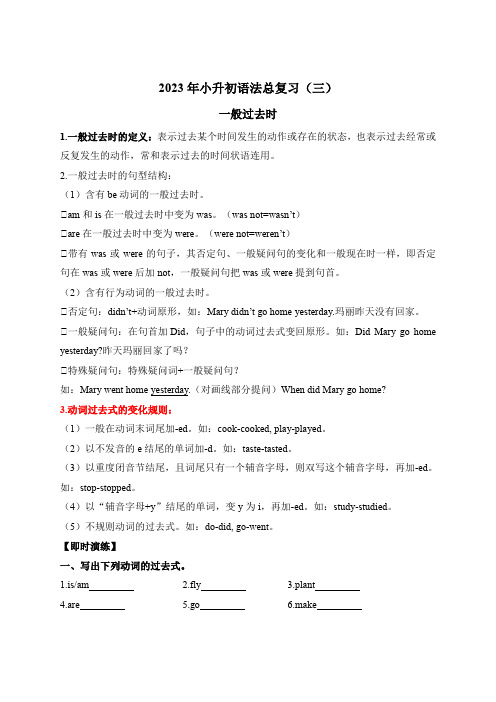
2023年小升初语法总复习(三)一般过去时1.一般过去时的定义:表示过去某个时间发生的动作或存在的状态,也表示过去经常或反复发生的动作,常和表示过去的时间状语连用。
2.一般过去时的句型结构:(1)含有be动词的一般过去时。
①am和is在一般过去时中变为was。
(was not=wasn’t)①are在一般过去时中变为were。
(were not=weren’t)①带有was或were的句子,其否定句、一般疑问句的变化和一般现在时一样,即否定句在was或were后加not,一般疑问句把was或were提到句首。
(2)含有行为动词的一般过去时。
①否定句:didn’t+动词原形,如:Mary didn’t go home yesterday.玛丽昨天没有回家。
①一般疑问句:在句首加Did,句子中的动词过去式变回原形。
如:Did Mary go home yesterday?昨天玛丽回家了吗?①特殊疑问句:特殊疑问词+一般疑问句?如:Mary went home yesterday.(对画线部分提问)When did Mary go home?3.动词过去式的变化规则:(1)一般在动词末词尾加-ed。
如:cook-cooked, play-played。
(2)以不发音的e结尾的单词加-d。
如:taste-tasted。
(3)以重度闭音节结尾,且词尾只有一个辅音字母,则双写这个辅音字母,再加-ed。
如:stop-stopped。
(4)以“辅音字母+y”结尾的单词,变y为i,再加-ed。
如:study-studied。
(5)不规则动词的过去式。
如:do-did, go-went。
【即时演练】一、写出下列动词的过去式。
1.is/am2.fly3.plant4.are5.go6.make7.taste 8.throw 9.ask10.buy 11.bring 12.draw13.kick 14.dance 15.catch16.play 17.drink 18.put二、用所给动词的适当形式填空。
小升初语法--名词(课件)-译林版英语六年级下册
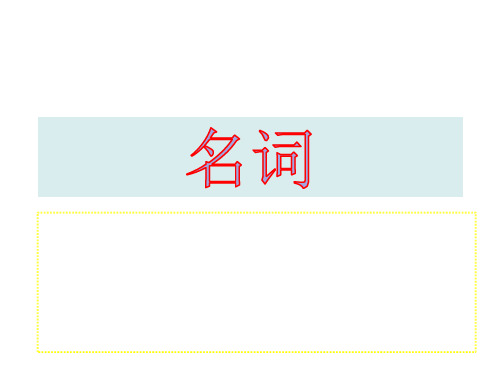
以o结尾的单词,单数变复数时,一般在词末加 “s”。但在顺口溜“英雄爱吃土豆和西红柿”中, 特指的三个词变复数时加“es”,词尾读/z/ hero→heroes 英雄 potato→potatoes 土豆 tomato→tomatoes 西红柿
3 单数变复数的不规则变化
变化形式 元音字母变
三、根据汉语意思,写出下列名词的所有格
1.小明的台灯 Xiaoming's lamp .
2.教室的窗户 the window(s) of the. classroom
3.汽车的颜色 the colour of the ca.r
4.女士包 women's bag
.
有讲有练
一、将下列单词分类
A.doctor B.Paris C.race D. supermarket E. sheep
F.weather G. the Summer Palace H.secret I.stone
1.专有名词: B
G
.
2.可数名词: A C D E H I .
3.不可数名词: F
3 复数名词不以s结尾时,加’s
children's books
童书
women's clothes
女装
4 表示几个人共有一样东西时,在最后一个人的 后面加’s;表示几个人各自所有时,在每一 个人的后面加’s
Jacob and Abby's desk 雅各布和艾比的课桌
一张课桌,两个人共有
Amy's and Zoe's rooms 埃米的房间和佐伊的房间
2.’s所有格
1 单数名词,直接在词尾加’s the girl's room 女孩的房间 the cat's tail 猫的尾巴 my boss’s son 我老板的儿子
[译林版]六年级小升初语法:形容词和副词
![[译林版]六年级小升初语法:形容词和副词](https://img.taocdn.com/s3/m/74f30bd3f605cc1755270722192e453610665b1f.png)
[译林版]六年级小升初语法:形容词和副词六年级英语小升初核心语法:形容词与副词姓名得分一.选择正确的答案,打√。
(15)1.XXX.XXX.2.XXX.3.To our surprise, XXX.4.Please write your report careful/ carefully.5.Mr Zhang is working in the office busy/ busily.6.It XXX.7.I feel difficult to learn words by heart and I often XXX imagine how _happy/happily_ I was when I ride to school on my bicycle.9.People in different countries behave(举止,行动) different/differently when they have dinner.二.单项挑选。
(25)1. We are. Because his story is not.A. tired; XXX; XXX; deliciousD. happy; interesting2.It’svery. Please close the door and the windows.A. XXX3. Jack went to school. His parents were angry.A. XXX4. The children are sleeping. Please walk.A. XXX5. Tomgoes to the zoo. The dogs there know him.A. XXX6. It’XXX.A. XXX7. This river is.A. 500 meter longB. 500 meters longC. 500 long metersD. 500 long meter8. Is this a photo of your daughter? She looksin the pink dress!A. XXX9. XXX.A. XXX XXX. The ice in the lake is about one meter. It’s strong XXX.A. XXX11. I XXX do today.A. anything XXX to me, Jack. Because I canread the words in the newspaper.A. XXX13. XXX most of the time. So they never feel.A. XXX14. XXX it was raining.A. XXX15. XXX.A. XXX16. ---Mr Smith, would you please speak a little more?---Sorry! I thought you would follow me.A. XXX117.XXX I add some sugar.A. XXX bad18. The shoes sell, XXX.A. good; wellB. good; goodC. well; wellD. well; good19. He is aworker and does everything.A. careful; carefulB. carefully; carefullyC. carefully; carefulD. careful; carefully20. XXX we are in the reading room.A. XXX21. The Internet is very useful for us. We can find information.A. XXX22. It was veryin the classroom, so the teacher had to walk.A. quiet; XXX; XXX; XXX; quietly23. The silk(丝绸) feels.A. XXX(光滑的)D. smoothly24. We love to go to the country in spring as the XXX.A. XXX25. ---Your XXX?---I’ve broken his vase.A. happy; XXX; angrilyC. happy; angrilyD. happily; angry 三.根据句意及所给提示,用括号中所给单词的适当形式填空。
译林版小升初英语知识点大汇总

译林版小升初英语知识点大汇总一、动词时态一般现在时1、概念:表示经常发生的动作或存在的状态。
2、时间状语:always,usually,often,sometimes,everyday/week/month/year,once a week/day/month/year,on Sundays,in the morning/afternoon/evening。
3、基本用法1)肯定的陈述句:主语+动词+其他成分。
如:I have a pen.我有一支钢笔。
2)否定的陈述句:主语+don’t/doesn’t+动词原形+其他成分。
如:I don’t like basketball.我不喜欢篮球。
4)一般疑问句:Do/Does+主语+动词原形+其他成分?肯定回答:Yes,主语+do/does。
否定回答:No,主语+don’t/doesn’t。
如:-Do you like English?你喜欢英语吗?-Yes,I do.是的,我喜欢。
-Do they have a computer?他们有一台电脑吗?-No,they don’t.不,他们没有。
现在进行时1、概念:表示正在发生的动作或存在的状态。
2、时间状语:now,at present,in the am/pm,this week/month/year,等。
3、基本用法:主语+be+动词ing+其他成分。
如:We are doing our homework now.我们现在正在做我们的家庭作业。
二、物主代词顺口溜记忆法物主代词分两种,形容词性名词性。
形容词性能力弱,后面跟着名词来修饰。
名词性独立主格,后面没有名词跟着走。
他的她的它的物,名词性物主代词单独使用。
三、名词所有格用法顺口溜名词所有格有两种形式:’s和of。
一般情况下,有生命的名词所有格用’s来表示;无生命的名词所有格用of来表示。
名词所有格的用法口诀:名词所有格,表物是“谁的”,若为生命词,加’s即可行,词尾有s,仅把逗号择;并列名词后,各自和共用,前者分别加,后者最后用;定冠词接名词,“谁的”或“共同”,疑问词意“什么”,三者均不行;省略of表所有,一般加名词;普通没有生命词,我们用of来描写。
【无锡重点小学】小升初英语语法复习讲义(梳理+基础+拔高)——代词 译林版(含答案)
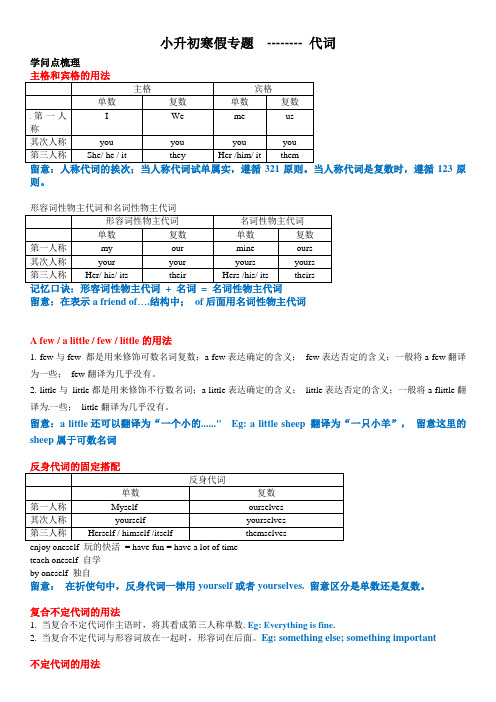
小升初寒假专题-------- 代词学问点梳理主格和宾格的用法主格宾格单数复数单数复数第一人I We me us称其次人称you you you you第三人称She/ he / it they Her /him/ it them留意:人称代词的挨次;当人称代词试单属实,遵循321原则。
当人称代词是复数时,遵循123原则。
形容词性物主代词和名词性物主代词形容词性物主代词名词性物主代词单数复数单数复数第一人称my our mine ours其次人称your your yours yours第三人称Her/ his/ its their Hers /his/ its theirs记忆口诀:形容词性物主代词+ 名词= 名词性物主代词留意:在表示a friend of….结构中;of后面用名词性物主代词A few / a little / few / little的用法1. few与few 都是用来修饰可数名词复数;a few表达确定的含义;few表达否定的含义;一般将a few翻译为一些;few翻译为几乎没有。
2. little与little都是用来修饰不行数名词;a little表达确定的含义;little表达否定的含义;一般将a flittle翻译为一些;little翻译为几乎没有。
留意:a little还可以翻译为“一个小的......" Eg: a little sheep 翻译为“一只小羊”,留意这里的sheep属于可数名词反身代词单数复数第一人称Myself ourselves其次人称yourself yourselves第三人称Herself / himself /itself themselvesteach oneself 自学by oneself 独自留意:在祈使句中,反身代词一律用yourself或者yourselves. 留意区分是单数还是复数。
复合不定代词的用法1. 当复合不定代词作主语时,将其看成第三人称单数. Eg: Everything is fine.2. 当复合不定代词与形容词放在一起时,形容词在后面。
- 1、下载文档前请自行甄别文档内容的完整性,平台不提供额外的编辑、内容补充、找答案等附加服务。
- 2、"仅部分预览"的文档,不可在线预览部分如存在完整性等问题,可反馈申请退款(可完整预览的文档不适用该条件!)。
- 3、如文档侵犯您的权益,请联系客服反馈,我们会尽快为您处理(人工客服工作时间:9:00-18:30)。
(译林版)小升初英语语法整理一、时态1.一般现在时(1)表示经常发生的动作或事情,通常用“usually通常, often常常, every…每…, sometimes有时,always总是,”等词。
(2)基本结构:I / You / We / They He / She / It肯定句动词原形动词第三人称单数形式否定句don’t + 动原doesn’t + 动原一般疑问句(Yes/No) Do… ? Yes, I do.Does…(动词原形)…?No,she doesn’t.特殊疑问句What do …?How does she…(动词原形)…?(3) 动词第三人称单数形式(同名词单数变成复数方法相同)1 一般情况 +s 如:walk-walks2. 辅音字母+y结尾去y +ies fly-flies3. 结尾是 s, x, sh, ch +es watch-watches4. 特殊的 do-does ,have-has, go-goes2.现在进行时,(1)表示正在发生的动作,通常用“now现在, look看,linsen听”.(2)基本形式: be + 动词ingeg: I am(not) doing my homework.You/We/They are(not) reading.He/She/It is(not) eating.What are you doing?Is he reading?(3)动词的现在分词形式(动词+ing)一般情况 +ing walk—walking结尾是不发音的 e -e + ing come—coming重读闭音节双写最后一个字母+ing run-runningswim-swimming3. 一般过去时(1)表示过去已经发生的事情,通常用“last …上一个…, just now刚才, a moment ago刚才, yesterday昨天”等词。
(2) be 动词的过去式: am/is—was are—were(3)过去式基本结构肯定句(Positive)动词过去式 I went shopping last night.否定句(Negative) Didn’t + 动词原形I didn’t go shopping last night.一般疑问句(Yes/No) Did …+ 动词原形…? Did you go shopping last night?特殊疑问句(wh-) What did…+ 动词原形…? What did you do last night?(4)词过去式的变化:规则动词的变化:一般动词 +ed planted,watered,climbed以不发音的e结尾 +d liked辅音字母加y结尾 -y+ ied study—studied, cry- cried重读闭音节单词,末尾只有一个辅音字母双写最后一个字母+ed stop –stoppedplan - planned不规则动词的变化:原形过去式原形过去式原形过去式原形过去式sweep swept teach taught have had go wentkeep kept think thought do did find foundsleep slept buy bought eat ate say saidfeel felt drink drank is/am was take tookread read give gave are were mean meantput put sing sang drive drove meet metcut cut begin began speak spoke make madelet let ring rang write wrote see sawfly flew run ran ride rode come camedraw drew sit sat hear heard tell toldgrow grew learn learned/ learnt get got know knew4.一般将来时一般将来时表示将来打算做的事或将要发生的事情。
常常与tomorrow, next Sunday等时间状语连用。
结构:be going to +动词原形或will +动词原形例如:I’m going to visit my grandpa next week.二、人称代词主格 I we you he she it they宾格 me us you him her it them形容词性物主代词 my our your his her its their名词性物主代词 mine ours yours his hers its theris(注:介词,动词后面跟宾格。
后面没有名词时用名词性物主代词。
)三、可数名词的复数形式1.一般名词: + s a book –books2.辅音字母加y结尾: - y+ ies a story—stories3.以s, x,sh, ch ,结尾: + es a glass—glasses;a watch-watches4.以f或fe结尾: - f 或fe 变为 ves a knife –knives a shelf-shelves5.特殊的名词复数man-men, woman-women, policeman-policemen, policewoman-policewomen, mouse-micechild-childrenfoot-feet,.tooth-teethfish-fish, people-people, Chinese-Chinese, Japanese-Japanese四、不可数名词(没有复数形式)bread, rice, water, juice,milk,tea,coffee五、缩略形式I’m = I am you’re = you are she’s = she is he’s = he is /he has(got)it’s = it is who’s =who is can’t =can not isn’t=is not didn’t=did not weren’t=were not wasn’t=was not let’s=let us I’ll=I will六、a. an .the的用法1.单词的第一读音是辅音读音:a book, a peach,a “U”单词的第一个读音是元音读音:an egg, an hour,an “F”2.the要注意的:球类前面不加the,乐器前面要加the,序数词前面要加the。
七、介词1.表示方位:on, in ,in front of, between, next to, near, beside, at, behind.,under2.表示时间:(1)at : 几点前面用at如:at six o’clock, 没有day的节日前用at如:at Christmas, 固定词组 at the weekends ,at night(2)on: 星期前用on 如:on Monday ,日期前用on 如:on the 15th of July 带有Day的节日前用on 如: on National Day(3)in: 早晨,中午,晚上前用in:in the morning ,in the afternoon ,in the evening ,月份前用in ,如in December ,季节前用in ,如 winter八、基数词变成序数词的方法1. 直接在基数词词尾加上th。
如:seventh第七,tenth 第十,thirteenth 第十三,2.以y结尾的基数词,变y为i,再加上eth。
如:twentieth 第二十。
3.不规则的。
如:first 第一, second 第二, third 第三,fifth 第五, eighth 第八,ninth 第九,twelfth 第十二。
4.有两个或以上单词组成的基数词只改最后一个单词如twenty-first 第二十一。
九、some /any的用法1.肯定句中用some:I have some toys in my bedroom.2.问句和否定句中用ang:Do you have any brothers or sisters?He hasn’t got any pencils in his pencil-case.3.询问想要什么时用some:Would you like some juice?Can I have some stamps?十、 there be结构1.肯定句(有…): There is +单数或不可数名词There are +复数注:遵循就近原则,看靠there be最近的2.一般疑问句(有…吗?):Is there …? Yes, there is./ No, there isn’t.Are there…? Yes, there are. /No, there aren’t.3.否定句(没有):There isn’t …. There aren’t….4.there be句型与have(has) 的区别:there be 表示在某地有某物(或人);have(has) 表示某人拥有某物。
十一、祈使句Sit down pleaseDon’t sit down, please.Let’s go to the park.(注:祈使句中动词用原形)十二、(情态)动词can, may, must, should, will 后面直接用动词原形。
1. I / He / She / They can sing. May I come in? I must go now.2. You should be quiet in the library.3. You’ll be good friends.十三、形容词和副词的比较级一、形容词的比较级1、两个事物或人的比较用比较级,比较级后面一般带有单词than。
比较级前面可以用more, a little 来修饰表示程度。
2.形容词加er的规则:⑴一般在词尾加er ;⑵以字母e 结尾,加r ;⑶以一个元音字母和一个辅音字母结尾,应双写末尾的辅音字母,再加er ;⑷以“辅音字母+y”结尾,先把y变i,再加er 。
3.不规则形容词比较级:good-better, beautiful-more beautiful二、副词的比较级1.形容词与副词的区别 (有be用形,有形用be;有动用副,有副用动)⑴在句子中形容词一般处于名词之前或be动词之后⑵副词在句子中最常见的是处于实义动词之后2.副词比较级的变化规则基本与形容词比较级相同 (不规则变化:well-better, far-farther)十四、特殊疑问句What(问什么事,什么物或什么工作) What are you doing?I’m reading.What is that? It’s a book.What is she?(What’s her job?)She’s a nurse.What colour(问颜色) What colour is your coat?It’s red.What time(时间) What time is it?What’s the time?It’s seven.when(什么时候) When do you get up? I get up at six thirty.When is your birthday? It’s on the 21st of December.Which(哪一个) Which is your watch, the yellow one or the white one? The yellow is mine.Who(谁) Who is the man with a big nose? He’s my uncle.Whose(谁的) Whose bag is it?Whose is this bag? It’s his bag.Where(哪里) Where is my ball pen? It’s under the book.Why(为什么) Why do you like summer? I like summer because…How many (多少) How many books are there in the school bag? There are four books in the school bag. How old (几岁) How old is the young man? He’s nineteen.How much(多少钱) How much is the toy bear? It’s eleven yuan.How (怎么样) How do you go to school everyday? I go to school by car.。
